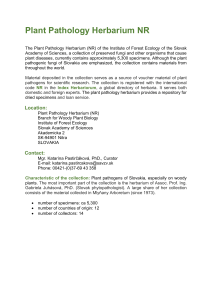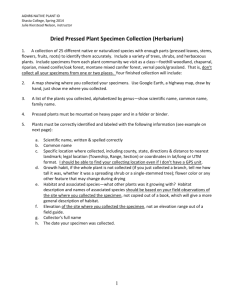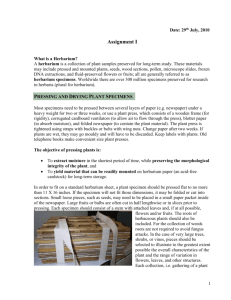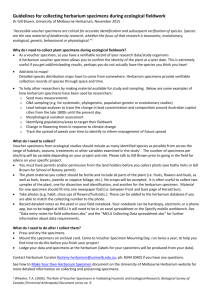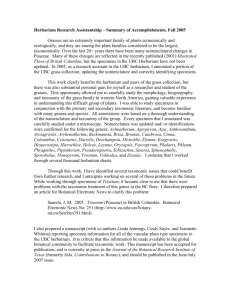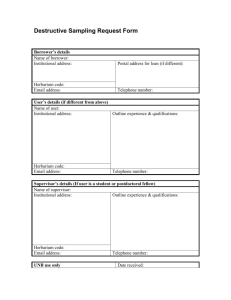UCO HERBARIUM POLICIES AND PRACTICES
advertisement
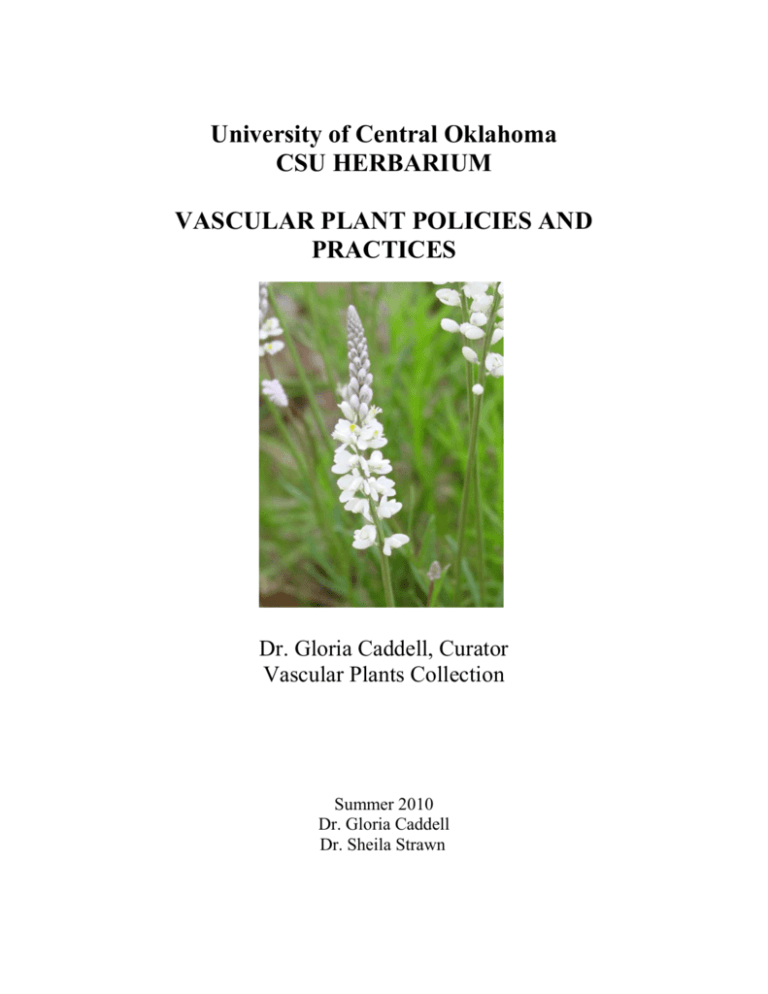
University of Central Oklahoma CSU HERBARIUM VASCULAR PLANT POLICIES AND PRACTICES Dr. Gloria Caddell, Curator Vascular Plants Collection Summer 2010 Dr. Gloria Caddell Dr. Sheila Strawn I. II. III. IV. V. VI. VII. VIII. IX. X. XI. XII. XIII. XIV. XV. XVI. XVII. XVIII. XIX. TABLE OF CONTENTS Overview of the Herbarium and Goals Purpose of this Manual Description of Collection Location of the Herbarium Arrangement of Specimens Funding Support Access to the Collection Use of the Herbarium A. General Guidelines B. Treatment of Specimens and Biological Materials before entry into the herbarium C. Handling of Specimens D. Annotating Specimens E. Destructive Sampling Policy F. Citing the Herbarium G. Equipment Available H. Assistance with Plant Identification Specimen Loans Collections Management A. Standards of Professional Practice and Code of Ethics B. Curator’s responsibilities C. Collection Manager’s responsibilities D. Graduate and Undergraduate Student Assistants’ responsibilities Procedures for Preparation of Herbarium Specimens A. Collection, Pressing, and Drying of Specimens B. Specimen Label Preparation C. Mounting Specimens D. Packet Preparation E. Deep-freezing specimens Procedures for Stamping, Accessioning, Filing, and Deaccessioning of Herbarium Specimens A. Training B. Stamping Specimens with Herbarium Accession Number C. Entering Specimen Data in Herbarium Databases D. Filing Specimens E. Data Backup F. Deaccessioning or Disposal of Specimens Protocol for Sending Data to Oklahoma Vascular Plant Database at the Oklahoma Biological Survey Protocol for Entering Data into Specify Integrated Pest Management Dust Control Collection Security Computer Use Useful References, Literature Cited, and Useful Links I. Overview of the Herbarium and Goals The University of Central Oklahoma Herbarium, a section of the University of Central Oklahoma Natural History Museum (UCONHM) houses a collection of ca. 12,500 vascular and non-vascular plants. Oklahoma plants make up the majority of the specimens, and there is a growing collection representing the Cimarron Gypsum Hills of northwestern Oklahoma. The Herbarium is used in several Biology courses, including Plant Biology, Plant Taxonomy, Plant Kingdom, Plant Ecology, Marine Biology, and Freshwater Biology. The goals of the Herbarium are to responsibly maintain and expand the collection, and to make specimens accessible for teaching, research, and outreach. It provides a record of the biodiversity of plants of Oklahoma, facilitates plant identification, and makes specimens available for research on plant distributions, evolution, and ecology. Specimen information is available to students, researchers, and the general public. The herbarium maintains an electronic database. Specimen data are made available to the scientific community through the Oklahoma Vascular Plants Database managed by the Oklahoma Biological Survey housed at the University of Oklahoma, and through Specify. In 2004, the American Society of Plant Taxonomists issued a position statement that emphasized the importance and value of plant collections in teaching, basic and applied research, and outreach, and stressed the need to support and maintain collections so that they will be available indefinitely. The text of this position statement is available at:http://www.botany.org/plantsciencebulletin/psb-2004-50-4.php#American. II. Purpose of this Manual This manual outlines the policies and guidelines for the acquisition, accessioning, maintenance and protection, loaning, deaccessioning, and use of herbarium specimens. It also describes the duties and responsibilities of herbarium personnel, and serves as a resource for student assistants and users of the herbarium. III. Description of Collection Approximately 12,500 vascular plant specimens have been accessioned and are filed in 18 metal storage cabinets. Algae, mosses and lichens are contained in 1 metal storage cabinet. The vast majority (almost 90%) of specimens in the collection are of vascular plants collected in Oklahoma. Most specimens were collected by students enrolled in BIO 4294 and 5294 Plant Taxonomy. Other specimens include personal collections of faculty, voucher specimens of research done by faculty and students, and specimens received from other herbaria. There is also a small medicinal plants collection. IV. Location of Herbarium UCO’s Herbarium, designated CSU in Index Herbariorum, is located in Room LAB 152 of Howell Hall on the campus of the University of Central Oklahoma. V. Arrangement of Specimens Specimens are currently filed alphabetically by family. Within each family the genera and species are arranged in alphabetical order. Specimens from Oklahoma are filed in manila folders, those from other states are in green folders, those from other countries are in orange folders, and cultivated plants are in yellow folders. VI. Funding Support Facilities are provided by UCO, supplies are provided through student fees, and equipment is purchased through grants and research funds. The College of Math and Science provides release time for the Curator and funds for student workers. VII. Access to the Herbarium We welcome UCO faculty and students, and other researchers and visitors to the Herbarium, but please contact the Curator to obtain permission to access the herbarium collections for teaching or research. All users should follow the usage guidelines in this manual. First-time visitors who use the collections will be provided with information on the location and arrangement of specimens, availability of references and workspaces, and safety procedures. Requests from off-campus individuals to visit or tour the herbarium should be by mail or e-mail to Dr. Gloria Caddell, Department of Biology, U. of Central Oklahoma, Edmond, OK 73034 or gcaddell@uco.edu. VIII. Use of the Herbarium Users should follow these guidelines: A. General Guidelines • Abide by conservation and safety regulations posted in the herbarium. • Ask for assistance, if needed, with locating specimens. • Smoking and tobacco products are prohibited in the herbarium. • No food or drinks are allowed in the herbarium. • Herbarium specimens should be treated for pests before being brought from the prep room into the herbarium. • Biological materials (books, paper) should be treated for pests before being brought into the herbarium. • Lights should be turned off when the herbarium is unoccupied. • Visitors are requested to sign the guestbook. B. Treatment of Specimens and Biological Materials before entry into the herbarium • All specimens and biological materials should be deep frozen for at least 48 hours to kill pests before they are brought into the herbarium. C. Handling of Specimens • Hands should be clean before handling specimens. • Gently open and close the cabinets. • Use two hands to remove and carry folders; carry folders in a horizontal position. • Support specimens with both hands, keeping them in a horizontal position (face up). Do not turn them over like pages of a book. • If you need to retrieve a specimen or specimens from the middle of a stack of specimens within a folder, pick up stacks of several specimens at a time and place them to the side until you reach the desired specimen(s). • Do not remove specimens from the herbarium without permission of the Curator. • Do not photograph or photocopy specimens without permission from the Curator. • Do not remove any plant parts from herbarium specimens without permission from the Curator. • If material comes loose as you handle a specimen, place it in a packet on the sheet; notify herbarium staff if the sheet lacks packets. • Notify herbarium staff of any evidence of insects or of recent insect damage to specimens. • Notify the Curator of any misidentified or misfiled specimens, or specimens in need of repair. • Keep herbarium cabinet doors closed unless you are removing specimens from them. • Do not leave specimens out of cabinets overnight. • Exercise extreme care if you re-file specimens to ensure they are filed in their proper place. The Herbarium staff can re-file specimens if needed. • Wash hands after handling specimens. D. Annotating Specimens Annotations by experts and by the Curator should be handwritten in permanent ink or typed on archival annotation labels. The scientific name, its author, the annotator’s name and the date should be on the annotation label. The format for annotation labels is in a file on the herbarium computer. Labels should be glued above the specimen label. If needed, the herbarium staff can assist with this. E. Destructive Sampling Policy Researchers wishing to remove samples from herbarium specimens for DNA analysis, etc. need to obtain prior permission from the Curator. F. Citing the Herbarium When specimens from the collection are cited in a research publication, the Index Herbariorum designation “CSU” should be cited. Clarification of location may be necessary, because it differs from the University’s acronym “UCO”. G. Equipment Available Plant presses, plant dryers, dissecting microscopes and tools, folders, and labels are available. The Curator, Collections Manager, and Student Assistants can provide help to persons needing to use these items. H. Assistance with Plant Identification If available, the Curator or student assistants will be pleased to assist with plant identifications. IX. Specimen Loans Researchers associated with any herbarium may request a loan of specimens. Contact the Curator, stating the name of the project and the taxa of interest, and ask for a loan request form. Upon its return, the specimens will be shipped. We expect specimens to be protected from pests during the loan period. Loans may be granted for up to one year with permission from the Curator. A log of incoming and outgoing loans is available on the herbarium computer. This should be updated each time a loan is processed. Hard copies of loan records should also be filed. The loan database should be queried annually and notice sent to borrowers regarding outstanding loans. When outgoing loans are taken from the cabinet, a tag should be placed in the cabinet indicating the location to which the specimens were loaned. Damaged specimens should be repaired before shipment. Sheets should be placed between rigid cardboards, and tied with twine. Pack boxes securely with packing material so that they do not shift or rub against each other. Include a packing list and number boxes (i.e. “1 of 3”). Within UCO only verbal permission is necessary for faculty to temporarily remove specimens from the herbarium for use in class, for an off-campus presentation, etc. However the loan and a record of verbal permission must be recorded in the database. X. Collections Management A. Standards of professional practice and Code of Ethics Herbarium practices will follow standards and guidelines in the Code of Ethics of the International Committee of University Museums and Collections, a committee of the International Council of Museums. The Code of Ethics is available at: http://icom.museum/ethics.html. All individuals associated with the herbarium will: • • • • • • • protect and conserve the herbarium specimens because they are irreplaceable facilitate the use of the herbarium specimens for teaching and research use the most acceptable methods of conservation and management strive to improve the scientific and educational value of the collection use good judgment about dissemination of information that could jeopardize rare or endangered plants deny access to users who fail to follow the policies in this manual clearly identify any specimens that are hazardous or have been treated with chemicals that make them unsafe to handle. B. Curator’s responsibilities The Curator of the herbarium is a faculty member of the Department of Biology with experience collecting, identifying, and mounting plant specimens. Currently Dr. Gloria Caddell is the Curator of the collection. The Curator is responsible for the collection and accessioning of specimens, herbarium policies and procedures, and maintenance of a digital database that is periodically uploaded to the Oklahoma Vascular Plants Database and to Specify. The Curator collaborates with the Collections Manager and together they supervise the work of the student assistants. C. Collections Manager’s responsibilities The Collections Manager of the UCO Natural History Museum has training in specimen preservation, works to maintain the integrity and quality of the collection under the supervision of the curator, and supervises student assistants in the management and maintenance of the collection. The Collections Manager attends meetings and workshops, as needed, to remain current on herbarium practices. Ms. Lynda Loucks is the current Collections Manager. D. Graduate or Undergraduate Student Assistants’ responsibilities Undergraduate or graduate students, trained by and under the direct supervision of the Collections Manager or Curator, mount, accession, and file specimens, and carry out other duties assigned by the Curator, Manager or other botany faculty member. Some tasks of the student assistants are to: • Sweep and remove debris and dust from surfaces in the herbarium and prep room. • Check insect traps & report results to the Collections Manager or Curator. • Mount plants. • Serial stamp and accession specimens. • Enter specimen data into Specify. • Deep-freeze specimens if needed. • File specimens in herbarium collection. • • • Clean sink. Discard trash and unusable paper products. Record hours worked, and indicate tasks completed. XI. Procedures for Preparation of Herbarium Specimens A. Collection, Pressing, and Drying of Specimens Specimens deposited in the herbarium are collected, pressed in a plant press, and dried in the plant dryer located in the herbarium prep room. Before collecting plant specimens, the following should be considered: • • • • • • • Permission from the appropriate agency or individual is needed for collecting specimens on private property, in national parks, national wildlife refuges, state parks, local parks, lands owned by the Nature Conservancy, etc. Always consider that removal of a plant from a population could have serious consequences for the population. Be aware of plants that are rare or endangered, and never collect them. Many taxonomists follow the 1 in 20 rule, i.e. don’t collect a plant unless there are at least 20 plants of the same species in the population. All specimens to be deposited in the herbarium should have complete collection data associated with them: country; state; county; scientific name; exact location (city, name of park, etc.; road, with distance from intersection with another road, mile marker, etc.; Township, Range, and Section Number; latitude and longitude or Global Positioning System – GPS- location if possible); habitat; elevation; associated species; size if a woody plant; abundance; a note of any traits that may change with drying, e.g. color or odor; collector’s name; collection number; and collection date. Specimens collected by a particular collector are numbered sequentially throughout the lifetime of the collector. Duplicates of a specimen (collected on the same date at the exact same location) are given the same collection number. The collector’s notebook, or copies of pertinent pages out of the notebook, should be deposited in the herbarium. Herbaceous plants should have underground parts – roots, rhizomes, bulbs, etc. All specimens should be in reproductive condition; flowering plants should have flowers, fruits, or both. The more quickly plants are pressed after they are collected, the higher the quality of the specimen. If plants are not pressed immediately, they should be wrapped in moist newspaper, placed in a plastic bag, and kept cool (preferably in an ice chest or refrigerator) until they can be pressed. Directions for pressing plants are as follows: • • • • • • • • • Within a plant press, which consists of a pair of wooden frames, specimens are placed in folded newspaper sandwiched between blotters, and then between corrugated cardboard ventilators. The specimen should fit into a space no larger than 11 x 16 inches so that it will fit on a sheet of mounting paper. Large plants may need to be pressed in more than one piece of folded newspaper. The collection number is written on the newsprint. Specimens may be trimmed, but all parts should be represented. Specimens may be folded, and if necessary the folds may be secured with a notecard with a slit into which the fold is inserted. This technique is particularly useful for grasses. The plant press straps should be tightened as much as possible. During drying, the plant press straps should be checked and tightened daily. Specimens are generally dried at 105-110o F. for at least three days. Specimens should be thoroughly dried before they are mounted; thick or succulent plant parts may take longer than three days to dry. A good reference for preparing plant specimens for deposit in a herbarium can be found at: http://www.flmnh.ufl.edu/herbarium/voucher.htm. B. Specimen Label Preparation A label template is in a file on the herbarium computer. Labels should include the following collection data: • Country, state, county • Scientific name and author • Exact location (city, name of park, etc.; road, with distance from intersection with another road, mile marker, etc.; Township, Range, and Section Number; latitude and longitude or Global Positioning System – GPS- location if possible) • Habitat • Elevation • Associated species • Size if a woody plant • Relative abundance • Description of any traits that may change with drying, e.g. color or odor • Collector name • Collection number (if a single plant has been mounted on more than one sheet, then after the collection number this is indicated by adding “1 of 2”, “2 of 2”, “1 of 3” etc.) • Collection date Specimen labels should be printed on acid-free paper. Examples of herbarium labels can be found at: http://www.flmnh.ufl.edu/herbarium/voucher.htm C. Mounting Specimens Before specimens are mounted, the Curator or Collections Manager will approve the mounting of all specimens to ensure that they were legally collected, in reproductive condition, free of mold, and are of high quality. Specimens are mounted on standardsized (11.5 X16.5 inches) archival, acid-free paper. Procedures for mounting specimens are as follows: . 1. Pour archival quality, clear drying white glue or Elmer’s ® glue onto a glass plate, adding water to thin it until it is the consistency of milk. Using a paintbrush, spread the glue over the glass. 2. Place a piece of mounting paper on a cardboard ventilator. 3. Using an acid-free white glue stick or undiluted white glue, glue the specimen label in the lower right hand corner. 4. Before gluing the specimen, aesthetically arrange it on the mounting paper so that there is white space around the specimen. The best side of the specimen should face up, but try to expose upper and lower leaf surfaces, flowers, and fruits. Trim excess branches so that branches do not overlap. If the plants are small, more than one specimen may be glued to a sheet. Leave room for annotation labels above the specimen label, and space for the specimen’s serial stamp in the upper left corner. 5. If a specimen must be split onto two or more sheets, the label should indicate, after the collector’s number, that the sheets are “1 of 2,” “2 of 2, “ “1 of 3, ” etc. 6. Extra flowers and fruits may be placed in a packet (see packet instructions below) attached to the mounting paper. 7. Large specimens may be folded into a “V” or “W” to fit the sheet. 8. Lift the specimen from the mounting paper and push it completely into the glue on the glass plate using a pair of tweezers, probe, or small card. Pick the specimen up with a pair of tweezers, and add glue to the underside with a small paintbrush if needed to ensure that the entire underside is covered. Then carefully lay the specimen on the sheet in the position planned earlier, and do not move it! Dust will adhere to any glue exposed on the paper by moving a specimen. 9. Cover the specimen with waxed paper. Use lead weights, if necessary, to weigh down parts that don’t lay flat. Place a piece of blotter paper on top of the waxed paper, then a cardboard ventilator. 10. Place a piece of mounting paper for the next specimen on the cardboard, and continue as above. 12. Books may be placed on top of the stack of mounted specimens to apply pressure for about 24 hours. 13. For specimens with stems that do not stay glued down after following the above procedures, a strip of glue may be placed from one side to the other across the stem. Place the mounted specimen on a cardboard ventilator, add the strip of glue, then place small wooden blocks near the corner of the mounting paper to keep the glue from contacting the cardboard above it. Place a cardboard ventilator on the blocks, then place the next specimen on top of the cardboard ventilator and continue. Let glue dry for 24 hours. D. Packet Preparation When small pieces of material are or become detached from the specimen, fold packets to hold those small pieces of specimens according to The Herbarium Handbook 3rd ed. (Bridson and Forman,1998). Use the alternative economic version made from a rectangle of acid-free paper. Glue only the center of the back side of the packet so that all edges are free to manipulate without damage to the specimen inside. E. Deep-freezing Specimens After the specimens and their labels have been mounted on the herbarium sheet, the specimens should be frozen for 72 hours at -30oC as recommended by The Herbarium Handbook 3rd ed. (Bridson and Forman, 1998) before being accessioned and filed in the herbarium. The specimens should be placed in extra-large plastic bags that can be tightly zipped closed before placing them in the freezer. After 72 hours the specimens are taken immediately to the herbarium, and after returning to room temperature (approximately 1 hour), are accessioned and filed, or placed in a temporary herbarium cabinet until they can be accessioned. XII. Procedures for Stamping, Accessioning, Filing, and Deaccessioning of Herbarium Specimens A. Training A PowerPoint presentation detailing accession procedures, and prepared by student assistant Jocelyn Bidlack, is available on the Desktop of the herbarium computer. All personnel accessioning specimens should carefully read it and follow the accessioning procedures. B. Stamping Specimens with Herbarium Accession Number Mounted specimens will be accepted for accession as directed by the curator. The serial number is stamped with the University’s name and the Index Herbariorum designation “CSU”. Check the databases for the last used number. The last used number should also be indicated on a card next to the stamp. Check that the serial stamp is turned to the next succeeding number. Stamp the specimen’s serial number in the upper left corner of the herbarium sheet. If there is no room, stamp it in the right-hand corner. If there is no room in either corner, stamp it anywhere on the sheet there is enough room, except above the label. That area should be reserved for annotation labels. Any specimens marked “1 of 2,” “2 of 2,” etc. should receive the same serial number. When specimens come from other collections and already have a serial number from that herbarium, our serial number should be stamped as close as attractively possible to it. Set aside any specimens in need of repair in a separate stack marked “Repair” as you stamp. C. Entering Specimen Data in Herbarium Databases All specimens are entered into an Excel database on the herbarium computer. There are four databases: “CSU Collections” for Oklahoma specimens, “CSU Collections out of state” for specimens collected in other states, “CSU Collections out of country” for specimens collected in other countries, and “CSU Collections cultivated” for cultivated plant specimens. The Excel worksheet includes columns for identification numbers of each specimen after it has been entered into Specify and into the Oklahoma Vascular Plants Database (OVPD). It is not necessary to enter these numbers as specimens are accessioned into the herbarium; they can be entered after the specimens are entered into Specify and the OVPD. Data entered into the Excel Databases are as follows: Country, State, County; Scientific Name; USDA Symbol; Locality; Township, Range, and Section Number; Habitat; Morphology; Associated Species; Collector; Collector’s Number; and Collection Date. If the specimen has been annotated, the original scientific name and USDA symbol are also entered. D. Filing Specimens Accessioned specimens, as well as returned loans or specimens removed for study, can be filed alphabetically by family, genus, and species into the herbarium cabinets. It saves time if specimens are first sorted into Oklahoma specimens, out-of state specimens, out-of-country specimens, type specimens, and cultivated specimens, then by family, genus, and species. Specimens from Oklahoma are filed in manila folders, those from other states in green folders, those from out-of-country in orange folders, and cultivated plants in yellow folders. Note that “escapes” are not considered cultivated! As specimens are filed, the following guidelines should be followed: 1. Carefully handle specimens; always keep them in a horizontal position. 2. Do not fill folders thicker than 1-1/2 inches. If there is more than one folder for a species, put the specimen into the thinnest folder. 3. Rearrange folders in a cabinet if needed because shelves are becoming too full; notify the Curator or Collection Manager if a cabinet is becoming too full. 4. Make and label new family and genus folders as needed. If a new genus folder is needed, be sure that corrections are made to other genus folders so that the specific epithets of the specimens within each folder are correctly indicated on the labels. If you cannot find a folder for a genus, check to be sure it has not been misfiled on an adjacent shelf. Inform the Curator when a new genus cover is made. 5. Watch for misfiled specimens and folders, and place them in their appropriate locations. 6. Watch for any evidence of insect infestation; immediately report it to the Collections Manager and Curator and take steps outlined under “Integrated Pest Management” in this manual. E. Data Backup Each week the specimen databases are copied to a flash drive that is stored in a fireproof safe in the Mammal section of the UCONHM. F. Deaccessioning or disposal of specimens Curators, Student Assistants, or the Collections Manager may propose the removal of a specimen from the collection due to its deterioration, duplication, or lack of adequate data. With approval from the Curator, duplicate specimens may be exchanged with herbaria of other institutions, donated to the teaching collection, or discarded. The Curator may designate that specimens with inadequate data or duplicates may be used in teaching labs where details of collection are not pertinent. Deteriorated specimens may be discarded with the approval of the Curator and the Collection Manager should see that the specimen’s data are removed from the database or a note is added that the specimen has been deaccessioned. XIII. Protocol for Sending Data to Oklahoma Vascular Plant Database Periodically, data entry will be uploaded to the Oklahoma Biological Survey’s Oklahoma Vascular Plants Database according to their specifications. It will be retrievable from computers at UCO. XIV. Protocol for Entering Data into Specify A PowerPoint presentation on entering data into Specify, prepared by student worker Jocelyn Bidlack, is available on the herbarium computer. All personnel beig trained to enter data into Specify should read it. Anyone entering data into Specify will first be trained by the Collections Manager and/or the Curator. XV. Integrated Pest Management Cabinets must be free of debris and evidence of insects. Insect traps are to be set and replaced as directed on containers. Traps should be checked weekly. To help prevent insect infestations, specimens should not be left out of cabinets when not in use, and should never be left out overnight. When insect evidence is observed (insects or insect parts, parts that have apparently been eaten, or powdered material), the Curator and Collections Manager should be notified. The cabinet will be thoroughly cleaned, and its contents deep-frozen. Place a sign in the cabinet that says “specimens in freezer”. Then the cabinet should be fumigated with “Tri-die” or other pyrethrin and silica gel. Place an insect trap in the bottom of the cabinet. In 72 hours, check the insect traps and if there are no signs of pests, place the specimens from the freezer back into the cabinet. Some families should be particularly monitored because they are more attractive than others to insect pests (Bridson and Forman, 1998): Asteraceae, Asclepiadaceae, Apocynaceae, Apiaceae, Brassicaceae, Ericaceae, Capparaceae, Caprifoliaceae, Valerianaceae. XVI. Dust Control Herbarium surfaces should be dusted and swept twice weekly in addition to housekeeping services’ scheduled maintenance. The prep room will be maintained by housekeeping services and swept or dusted by herbarium staff as needed. XVII. Collection Security The prep room and herbarium will be locked whenever they are not occupied. XVIII. Computer Use Use of the computer in the prep room of the herbarium is limited to the Herbarium Manager, Curators, and student assistants. The computer should be used only for work associated with the herbarium. XIX. Useful References, Literature Cited, and Useful Links Bridson, Diane, and Leonard Forman, (eds.)1998. The Herbarium Handbook. 3rd ed. Royal Botanic Gardens, Kew. Bailey Herbarium, College of Saint Benedict and St. John’s University. 2009. Accessed at http://www1.csbsju.edu/herbarium on August 15, 2010. Metsger, Deborah A. and Sheila C. Byers, eds. 1999. Managing the modern herbarium. Society for the Preservation of Natural History Collections, Washington, DC. Oklahoma Vascular Plants Database (OVPD). http://www.biosurvey.ou.edu/atlasdesc.html Open Herbarium. Accessed at http://herbarium.usu.edu/OpenHerbarium/plant%20collecting.htm on August 19, 2010. Robert Bebb Herbarium of the University of Oklahoma. Accessed at http://www.biosurvey.ou.edu/bebb/bebbhome.html on August 15, 2010. Snow, Neil. 2005. Successfully curating smaller herbaria and natural history collections in academic settings. BioScience 55(9): 771-779. University of Florida Herbarium. Preparation of plant specimens for deposit as herbarium vouchers. Accessed at http://www.flmnh.ufl.edu/herbarium/voucher.htm on August 19, 2010. University of North Carolina Herbarium.2010. Accessed at http://www.herbarium.unc.edu on August 15, 2010

